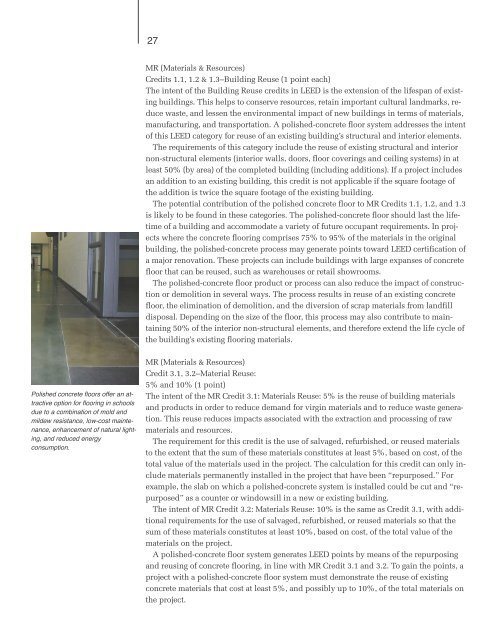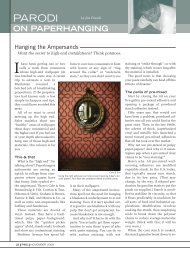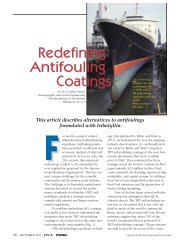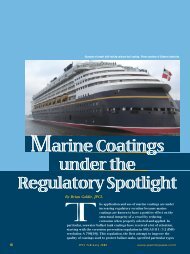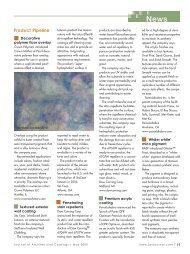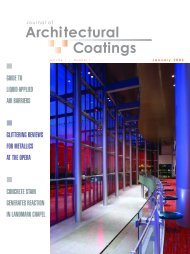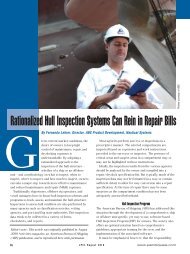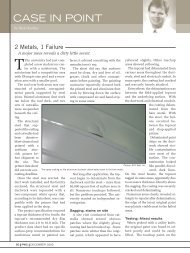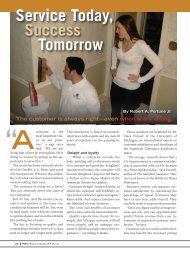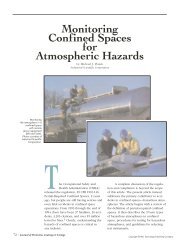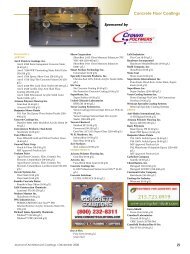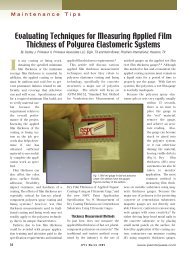Decorative Treatments for Concrete Floors: A ... - PaintSquare
Decorative Treatments for Concrete Floors: A ... - PaintSquare
Decorative Treatments for Concrete Floors: A ... - PaintSquare
You also want an ePaper? Increase the reach of your titles
YUMPU automatically turns print PDFs into web optimized ePapers that Google loves.
27MR (Materials & Resources)Credits 1.1, 1.2 & 1.3–Building Reuse (1 point each)The intent of the Building Reuse credits in LEED is the extension of the lifespan of existingbuildings. This helps to conserve resources, retain important cultural landmarks, reducewaste, and lessen the environmental impact of new buildings in terms of materials,manufacturing, and transportation. A polished-concrete floor system addresses the intentof this LEED category <strong>for</strong> reuse of an existing building’s structural and interior elements.The requirements of this category include the reuse of existing structural and interiornon-structural elements (interior walls, doors, floor coverings and ceiling systems) in atleast 50% (by area) of the completed building (including additions). If a project includesan addition to an existing building, this credit is not applicable if the square footage ofthe addition is twice the square footage of the existing building.The potential contribution of the polished concrete floor to MR Credits 1.1, 1.2, and 1.3is likely to be found in these categories. The polished-concrete floor should last the lifetimeof a building and accommodate a variety of future occupant requirements. In projectswhere the concrete flooring comprises 75% to 95% of the materials in the originalbuilding, the polished-concrete process may generate points toward LEED certification ofa major renovation. These projects can include buildings with large expanses of concretefloor that can be reused, such as warehouses or retail showrooms.The polished-concrete floor product or process can also reduce the impact of constructionor demolition in several ways. The process results in reuse of an existing concretefloor, the elimination of demolition, and the diversion of scrap materials from landfilldisposal. Depending on the size of the floor, this process may also contribute to maintaining50% of the interior non-structural elements, and there<strong>for</strong>e extend the life cycle ofthe building’s existing flooring materials.Polished concrete floors offer an attractiveoption <strong>for</strong> flooring in schoolsdue to a combination of mold andmildew resistance, low-cost maintenance,enhancement of natural lighting,and reduced energyconsumption.MR (Materials & Resources)Credit 3.1, 3.2–Material Reuse:5% and 10% (1 point)The intent of the MR Credit 3.1: Materials Reuse: 5% is the reuse of building materialsand products in order to reduce demand <strong>for</strong> virgin materials and to reduce waste generation.This reuse reduces impacts associated with the extraction and processing of rawmaterials and resources.The requirement <strong>for</strong> this credit is the use of salvaged, refurbished, or reused materialsto the extent that the sum of these materials constitutes at least 5%, based on cost, of thetotal value of the materials used in the project. The calculation <strong>for</strong> this credit can only includematerials permanently installed in the project that have been “repurposed.” Forexample, the slab on which a polished-concrete system is installed could be cut and “repurposed”as a counter or windowsill in a new or existing building.The intent of MR Credit 3.2: Materials Reuse: 10% is the same as Credit 3.1, with additionalrequirements <strong>for</strong> the use of salvaged, refurbished, or reused materials so that thesum of these materials constitutes at least 10%, based on cost, of the total value of thematerials on the project.A polished-concrete floor system generates LEED points by means of the repurposingand reusing of concrete flooring, in line with MR Credit 3.1 and 3.2. To gain the points, aproject with a polished-concrete floor system must demonstrate the reuse of existingconcrete materials that cost at least 5%, and possibly up to 10%, of the total materials onthe project.


